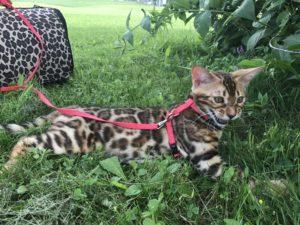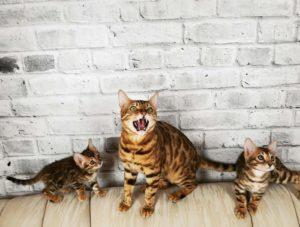Health and care for the Bengal cat. Let’s start with the most popular and frequently asked question: Are Bengal cats hypoallergenic?
ALLERGY TO BENGALS
Yes, Bengal cats have very short, thin coats and almost no down. Therefore, the breed is considered hypoallergenic.
But there is one correction! Allergies are caused not only by wool, but also by pieces of skin, saliva and urine of cats. Bengals are also cats. There is a risk that if you already have a cat allergy, then when dealing with Bengal cats, you will have the same symptoms. Perhaps in a weakened form. 50/50. (And on naked sphinxes too). F1 Bengals have a lesser allergic effect, which is probably why the whole breed is “considered” hypoallergenic, but these Bengals are not domestic cats, but practically wild ones, therefore they are not suitable for ordinary family life.
Also, the action of the allergen is cumulative. Cases when you stroke a cat, and flowed from the nose – are rare. The symptoms of a primary allergy always happen with a delay in time, I tell you this as a physician.
Most often it happens like this: you take a kitten, communicate with him, and after a week or a couple of weeks, nasal congestion appears; tickle in the throat; watery eyes, etc.

Drop this idea! How do you imagine it? Ask for a visit for 2 hours in an apartment to a busy stranger? Pet the kitties? You will spend your time and the breeder, and everything with your health will be fine as before.
You take a kitten… and that’s it, a sneeze!
According to the legislation, purchased animals, birds and plants are not subject to return. What do we do? Shed tears and blame the breeder? He has the right to refuse.
That’s why. If you have doubts about your health and the health of your family members, take cat allergy tests. They are of three types:
You will see the result in 30 minutes. This method is simple, it will show “yes” or “no”.
We have had several similar cases. People came to see the kitten. Warned in advance, I did not vacuum or wash the floors the day before, we talked for two hours, people played with cats and kittens, hugged and kissed them.
My work is standing, The meeting is postponed, Phone calls are missed, Important matters are postponed, It’s already time to feed the cats, But I’m standing, talking … Guests!
And no people have any symptoms! A week later they come back, buy a kitten. And here it is, nasal congestion on a kitten in a month.
In general, now I refuse to all those who want to experiment with me. These are live babies, not testers.
I also want to reassure you. Allergists advise. If you already have a kitten in your house, and you have mild allergy symptoms, do not rush to give it up.
To get started, try these tricks:
– when you play with him – then do not go into your mouth, eyes and nose with unwashed hands.
– reduce the risk of his scratches: do not tickle his belly and ribs. It tickles him, he begins to bite and fight. When he wants to fight with his hand – slip him a soft toy with a padding polyester inside. Also, regular care includes cutting the nails with a nail cutter, once every 4 weeks.
– Bengal kitten can be washed once a week with shampoos. Or wipe it with a damp cloth.
– often change the filler in the tray, do not allow it to dust and spread across the floor.
– if an adult cat and a cat began to shed, then the furminator will help you.
– And the usual methods: dusting with a vacuum cleaner, wet cleaning, airing, put clothes in the closet, reduce the number of “dust collectors” (carpets, fluffy decorative blankets), you can buy an air washer.
My husband has an asthmatic allergy to cats, but following these simple rules allows him to live fully, surrounded by cats.
And finally check it out! Suddenly it’s not an allergy to a kitten, but to a new detergent, dry kitten food, or some fabric or food.
I wish you all good and health!
Health and typical diseases of Bengal cats
Not all owners face the typical diseases of Bengal cats. Many pets live a long and happy life and visit the vet only for vaccinations. Nevertheless, it is better to know what problems may arise to prevent them or recognize them in time.
General health of Bengal cats

The health of Bengals, if they are animals from proven and reliable catteries, is quite strong. Breeders managed to exclude many genetic anomalies. In their blood there are genes of strong and enduring wild Bengal cats. But nevertheless, they are characterized by a number of problems and diseases.
Therefore, before buying a Bengal kitten, it is important to collect all possible information about his parents and breeders. A small saving can now turn into a long and expensive treatment.
The main diseases of Bengal cats
As a rule, Bengals have good health, but there are diseases that occur in representatives of this breed more often than usual: Health and care
Food poisoning, indigestion, bowel disease. Bengal has a very sensitive stomach, which reacts badly to the change of feed and poor nutrition. Most often they suffer from inflammatory bowel diseases.
Hypertrophic cardiomyopathy. This pathology of the structure of the heart, when one of the walls is thicker than the others. Violation of cardiac activity can lead to a variety of health problems, including sudden death. The danger of this disease lies in the absence of early symptomatology. It often does not manifest itself, therefore for Bengal cats it is important to have regular heart examination: ultrasound and ECG.
Flat chest syndrome. This disease of Bengals is peculiar only to kittens. Because of a breach of the structure of the chest, the ribs squeeze the chest cavity and interfere with normal breathing. As a rule, kittens with a severe stage of this syndrome die within the first days or weeks of life. If this did not happen, then the animal develops as expected.
Poor functioning of the immune system. This health problem is peculiar to the lines in which matings between close relatives were repeatedly allowed. For such animals, regular vaccination and deworming are especially important.
Of course, like other cats, Bengals tend to have urolithiasis, especially in regions with increased rigidity. Non-sterilized animals may experience hormonal disorders. For elderly cats, a frequent problem is cancer. Cats that eat natural soft food, and not dry food, suffer from an increase in tartar.
Prevention of diseases of Bengal cats
Prevention is always easier and cheaper than treatment, so all owners of Bengal cats are required to comply with these rules:

Purified water. In a bowl, there should always be enough clean and fresh water. You need to change it several times a day.
Fight against parasites. Even if the cat does not leave the house, you walk along the street and can bring parasites. Therefore every quarter it is necessary to conduct deworming and, if necessary, treatment from external parasites – fleas.
Vaccinations. It is important to do both a general inoculation against rabies, and complex specific ones – from the most common feline infections.
Inspection. Visiting a veterinarian and a general examination is important to repeat every year. It is convenient to combine it with the vaccine.
Sterilization. All the breeders unanimously affirm: the animal or participates in breeding work, or is sterilized. Another option, like “To give birth once,” “Give tablets so that they do not scream” are simply dangerous to health. In catteries, animals that have completed their breeding career are also sterilized.
Change of state. If the cat has behaved differently, the appetite worsened, the condition of the coat, the appearance, then the best once again show it to the vet.
Despite the fact that in Bengal cats diseases are rare, it is better to always be on your guard: the faster the help comes, the easier it will be to treat.